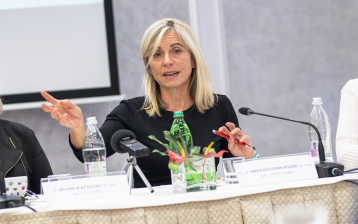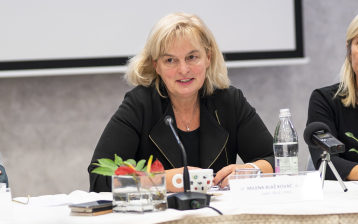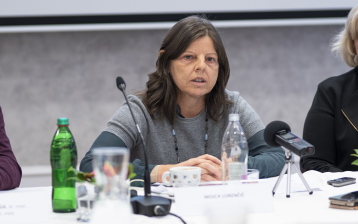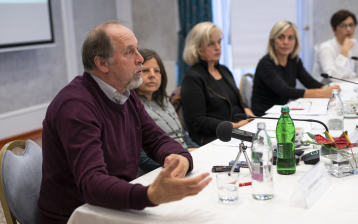
The path of clinical nutrition
Ljubljana, November 27, 2018 – According to World Health Organization data, there are today almost two billion people with obesity problems. At the same time, there are 33 million malnourished people in Europe. Every fourth patient admitted to a hospital is malnourished. The main form is protein-energy malnutrition. This is why hospital stays are getting longer, patients are feeling worse, and the costs of healthcare are increasing. This is true for Slovenia as well.

Dr. Rotovnik Kozjek, MD, PhD, anesthesiology specialist and vice president of Slovenian Clinical Nutrition Society (Photo MIRAN JURŠIČ)
“The key problem are the uneasy feelings when we discuss malnutrition because of its different connotation in the developed world compared to underdeveloped parts of the world. But the definition of malnutrition is the same everywhere: we talk about malnutrition when a patient does not have the necessary amount of energy or individual micro or macro nutrients in regard to their body structure, age, physical condition, or disease,” said Dr. Nada Rotovnik Kozjek from the Institute of Oncology Ljubljana and vice-president of the Slovenian Society for Clinical Nutrition at the press conference the Society held today.
Malnourished are mainly patients with cancer and the elderly
Numerous cases of malnourished patients she meets working at the clinical nutrition department of the Institute of Oncology confirm that malnutrition affects all body systems, primarily fitness and the immune system. It also causes emotional and cognitive disorders. But hospitals only see the tip of the iceberg. Patients come malnourished from the environment they live in and after completed treatment return to that environment. “Therefore it is of key importance to establish a clinical nutrition system at the level of the entire health system and especially at the level of primary healthcare in cooperation with those in charge of public health. This way we will admit into hospitals less malnourished patients with chronic diseases and will be able to better deal with these medical conditions,” points out Dr. Rotovnik Kozjek. To stand out are mainly patients with cancer. The success of their treatment is greatly affected by how we deal with malnutrition. One of the first victims of malnutrition is the immune system. “Our cancer medications are getting better, but before we can use them properly, we first need to strengthen the immune system through nutrition,” explained Dr. Rotovnik Kozjek.
The other often malnourished group are the elderly – in their old age they pay the price for the mistakes they’ve been causing to their health throughout their lives. In a society where slimming diets and uncontrolled use of dietary supplements run rampant, people at old age are more fragile than they needed to be. The solution is an individual approach and wholesome treatment of the individual.
Obesity is a chronic incurable disease

Dr. Milena Blaž Kovač, MD, PhD, family doctor specialist and president of Slovenian Clinical Nutrition Society (Photo MIRAN JURŠIČ)
Dr. Milena Blaž Kovač, a family physician at Health Centre Šiška, pointed out the significance of recognizing the nutritional dangers in the first phase when the necessary measures of nutritional treatment are still simple and effective: “At the family medicine clinic we deal with a population which aims to live by the recommendations of healthy nutrition. They tell they eat plenty of fruit and vegetables. They eat meat only two or three times per week. But once someone falls sick or grows old, these recommendations fail. Often chronic patients before difficult surgeries come to the clinic and ask what they should eat. They do not know what to choose from the long list of dietary supplements. In those cases, I wonder whether I possess enough knowledge to answer them and enough time to do so. That is why I wish for similar support as there is at the secondary level so I can refer the patient to a nutrition expert.”
Dr. Milena Blaž Kovač also warns about the wrong understanding of obesity, which is a chronic and incurable disease which one has to accept and properly deal with. She emphasizes the need for an individual and wholesome approach to obesity and later support. “We must encourage the patient to change life patterns and not to simply lose weight. We need to help them normalize their body composition, so they lose fat tissue rather than muscle mass. The process of regulating an individual’s body weight is very demanding. Only highly trained nutrition experts should deal with it. There are not many such experts in Slovenia, although it is easy to get the impression they are in fact numerous. Sadly, the truth is quite the opposite,” warns against professed experts and miracle diets Dr. Blaž Kovač, who is also the president of the Slovenian Society for Clinical Nutrition.
We are not defined by kilograms but by our body composition!
Doctors often meet in one patient at first glance two conflicting issues: obesity and malnutrition. “A problem in Slovenia are dogmas about obesity, which we only define through the body mass index (BMI). We are not defined by kilograms but by the composition of our body! Looking at a sick person through the prism of kilograms and BMI can be a huge issue. Or a doctor instructing an athlete with a body mass index of 30 to lose weight. Every doctor at the clinic must know how much knowledge they possess and where the experts are who can upgrade that knowledge,” Dr. Rotovnik Kozjek emphasizes the role of primary healthcare. The family physician must be aware of the importance of proper nutrition and protect patients from aggressive marketing approaches which aim to sell ‘miracle’ potions to cancer patients and fashionable diets to obese people.

Mojca Lorenčič, journalist and chronic kidney disease patient (Photo MIRAN JURŠIČ)
Each patient must be well informed regarding nutrition
Normally we welcome losing weight. But losing weight without conscious decision to do so must be met with a doctor visit. A disease might be the cause. When a patient loses weight, they mostly lose muscle mass, which makes it harder to combat the disease. Well-nurtured chronic patients better deal with diseases. Mojca Lorenčič, a journalist of the publishing company Dnevnik, a kidney patient herself, shares her experience with how nutrition affects the course of the disease. “Proper nutrition is an integral part of the kidney disease therapy. Every patient must be well informed regarding their nutrition. Kidney patients must be especially careful to limit the intake of fluids, phosphates, salts, and potassium. At the time of the diagnosis, 16 years ago, I received a bunch of papers with all the instructions and a list of forbidden foods. But this is not enough. A patient needs constant treatment and education regarding nutrition. Lately, due to the great threat of malnutrition, more attention is paid to this in the dialysis centres. This is the first institution where a deterioration of the nutritional condition should be detected, but unfortunately, no dialysis centre in Slovenia employs a clinical nutritionist, warned Mojca Lorenčič.

Dušan Baraga, MD, family doctor specialist and a patient with chronic inflammatory bowel disease (Photo MIRAN JURŠIČ)
Another institution to try to employ a clinical nutritionist is the association of patients with chronic inflammatory bowel disease. “The inflammation, which is part of the flare-up of the disease, consumes great amounts of energy and proteins. Comparable to constantly running a marathon. In case the lost energy and proteins are not replenished, loss of muscle mass occurs. Patients are usually also affected by lack of movement, which influences the immune system. These facts were discovered by the association in the last years, and this is the third year we focus mostly on the importance of nutrition. We organize numerous lectures and workshops. Patients can inform themselves on the disease and nutrition there,” explained Dušan Baraga, a patient with chronic inflammatory bowel disease and family practitioner at Health Centre Cerknica. Patients with this type of disease know it can be managed with proper nutrition, but they must be careful to have a high enough intake of the right calories and proteins. They also need expert advice on how to replace the foods they must avoid because they cause the flare-up of the disease. Another important element is the motivation to move. Movement strengthens the organism and prepares it to combat the disease during another flare-up.
PATIENT STORY
“We need new approaches in nutrition education of the patients”
Mojca Lorenčič is best known as a journalist of the publishing company Dnevnik, but she has been increasingly active as a promoter of kidney patient care. She is dealing with a chronic kidney disease of her own, having experienced a kidney failure at 33 years of age. After treatment with dialysis, her kidney was transplanted, but the transplant failed three years ago and Mojca is now again on dialysis treatment. She does not go to a dialysis centre, rather performing the so-called peritoneal dialysis at home with the assistance of a special device. This happens at night during sleep time, which enables her to lead a relatively undisturbed life.
Chronic kidney disease does not have any special warning signs. Early symptoms are proteins in the urine and increased blood pressure. Based on the level of kidney activity, the disease is divided into five stages. The fifth stage represents total kidney failure. Problems due to decreased kidney activity occur only a few months before kidney failure, once the kidneys are no longer able to filter toxins from the body and the patient becomes increasingly infected. At that point, it is too late for treatment.
Diet – an unavoidable part of the treatment
When dealing with chronic kidney disease, a proper diet is an unavoidable part of the treatment. “Nephrologists as early as in the third phase, and surely in the fourth, advise patients to limit the intake of protein foods, which is proven to slow the progress of the kidney disease. I received this same advice, as well as the advice to limit the intake of salt. The greatest diet change occurs when the kidneys fail, once the patient gets on dialysis treatment. At that point, the intake of proteins must suddenly be increased, as the dialysis and the processes in the organism cause proteins to be lost at a quick pace. It is also advised to limit the intake of potassium, phosphates, salts, and fluids. Potassium is found in fresh fruit and vegetables, meat, milk, nuts, potatoes … Phosphates are found where the proteins are, that is meat and meat products, milk and milk products, legumes … and in pre-cooked food, where phosphates are added as phosphate additives: such as instant soups, baking powder, soft drinks … The patients require a lot of knowledge on foods to be able to choose the most suitable ones. They must also plan their diet a day or several days in advance,” said Mojca Lorenčič. Some of the things are also quite illogical: she must increase the intake of proteins while limiting phosphates, which are contained in protein-rich foods. She must also limit the intake of salt – thus be able to prepare foods which are good without salt using herbs or other spices. This can be achieved only by a patient well-endowed with nutrition knowledge. The limitation on fluid intake is also quite harsh; a patient on dialysis may only ingest half a litre of fluid with food and drinks per day.
Mojca Lorenčič is fortunate not to have problems with potassium and does not need to limit her fluid intake. “I have to limit phosphates, though, which is why I gave up phosphor-rich foods like cheese, milk, yoghurt, hot dogs, salamis, instant soups, precooked food … A very good type of food is cottage cheese, which contains many proteins and not that many phosphates. Since I do not have to fully follow the diet, I don’t really have the feeling that I need to give up anything. But it might be problematic to eat away from home. You never know what they put in their food. I mostly prepare my own meals for work and heat them in the microwave oven.”
Many patients have problems managing the nutritional requirements
Many patients have problems managing all the nutritional requirements. Working with patients, Mojca notices that kidney patients’ greatest fear is increased potassium, a condition which may cause immediate cardiovascular complications, such as cardiac arrest. They are less inclined to follow the instructions regarding the intake of phosphates, probably because complications, in this case, are more long-term, such as bone damage.
When dealing with kidney failure, patients also receive nutrition training. Mojca still remembers the instructions she received 16 years ago. “But nutrition is just so complex. Patients are in constant need of education. In the last years, more attention was given to patient malnutrition in dialysis centres. General and protein malnutrition can develop quickly due to diet restrictions such as limiting fruit and vegetables (and thus vitamins and minerals) and too small an intake of proteins. Medical nurses in dialysis centres are specially trained and provide nutritional counselling to patients whose tests reveal they are experiencing issues with their diets. An evaluation of patients’ nutritional conditions is performed every three months, so any relevant deterioration of the condition should be detected. But unfortunately, no dialysis centre has a clinical nutritionist,” points out Mojca.
The recommended diets today are far less strict than those 16 years ago, Mojca notices when comparing modern guidelines to those encountered in the past. It regards mainly the limitation of phosphates and consequently protein foods. This is mostly due to the advancements in medicine, such as the use of medications which bind phosphates from the ingested food. Furthermore, in the last years, we saw the arrival of special proteins drinks, adapted to dialysis patients, which include proteins but not phosphates.
“All this helps patients greatly. But nutrition education of patients is still very important – a lot can be done here! A patient must not only know what foods are more and what foods are less appropriate but also why these limitations are necessary and what damage is caused by neglecting them. Another problem is patients’ motivation to eat in accordance with the recommendations and move more. We notice kidney patients do not get enough movement. We thus need new approaches to motivate patients, to simplify the nutritional principles and bring them closer to the patients – this is the only way to make them change their diets and contribute to the management of the disease.”

Studio interview with Dr. Rotovnik Kozjek for the afternoon news. Some newspaper and digital articles have already been published, and many more are expected including a special radio broadcast in January.


